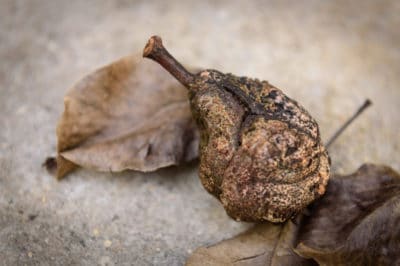Symptoms
Infection usually occurs in the spring when buds are swelling. Infected twigs overwinter the fungus in cankers that form in the fall which produce pustules on the ends that burst open releasing spores. The spores travel to new parts of the tree through the air and rain.
The leaves exhibit small brown spots that can be velvety to the touch. Infected pears also exhibit brown spotting that enlarges and rots the fruit over the season. Fruit can grow into irregular shapes once infected.
In areas where pears are grown commercially, the disease may be so present that it’s an eco-systemic problem. Gardeners in these regions will benefit from planting resistant varieties. Here is a list of scab-resistant pear varieties.
- Arganche – An early sweet pear ripening in July. Very flavorful round yellow fruit.
- Barnett Perry – A low-acid sweet pear. Small fruit, trees will grow compact.
- Santa Claus – Old French variety. Heat loving with large sweet fruit.
- Jargonelle – Very old variety of dessert pear. Green fruits of medium size are very sweet. Requires pollinator
- Gorham – Medium sized greenish yellow fruit. Sweet and musky good for eating and cooking.
Treatment
Remove all leaf mulch and mould from around the base of the tree. Do not compost this material. Fungal spores will survive decomposition and end up back on your trees. Keep the area raked and clean, use only clean finished compost as mulch.
Adding lime or urea to the fallen leaves will help to kill the fungus. Lime can also be sprinkled around the base of infected trees. Coordinate with neighbors in the region who also have pear or apple trees so they can do the same.
Avoid getting the foliage wet and prune the trees to allow for maximum airflow. Removing infected twigs before they burst and release spores in the spring will slow the spread.
Prevention
Treat any leaves that you bring onto your property with lime to avoid contaminating your trees. Healthy trees are more resistant to infection. Keep trees well trimmed, consistently watered, and give them plenty of organic compost both at the time of planting and as a mulch annually.
Sprays made of baking soda or copper have been known to boost resistance and prevent spreading. Once your trees have it, the goal is to combat it with your eyes on next years crop.
